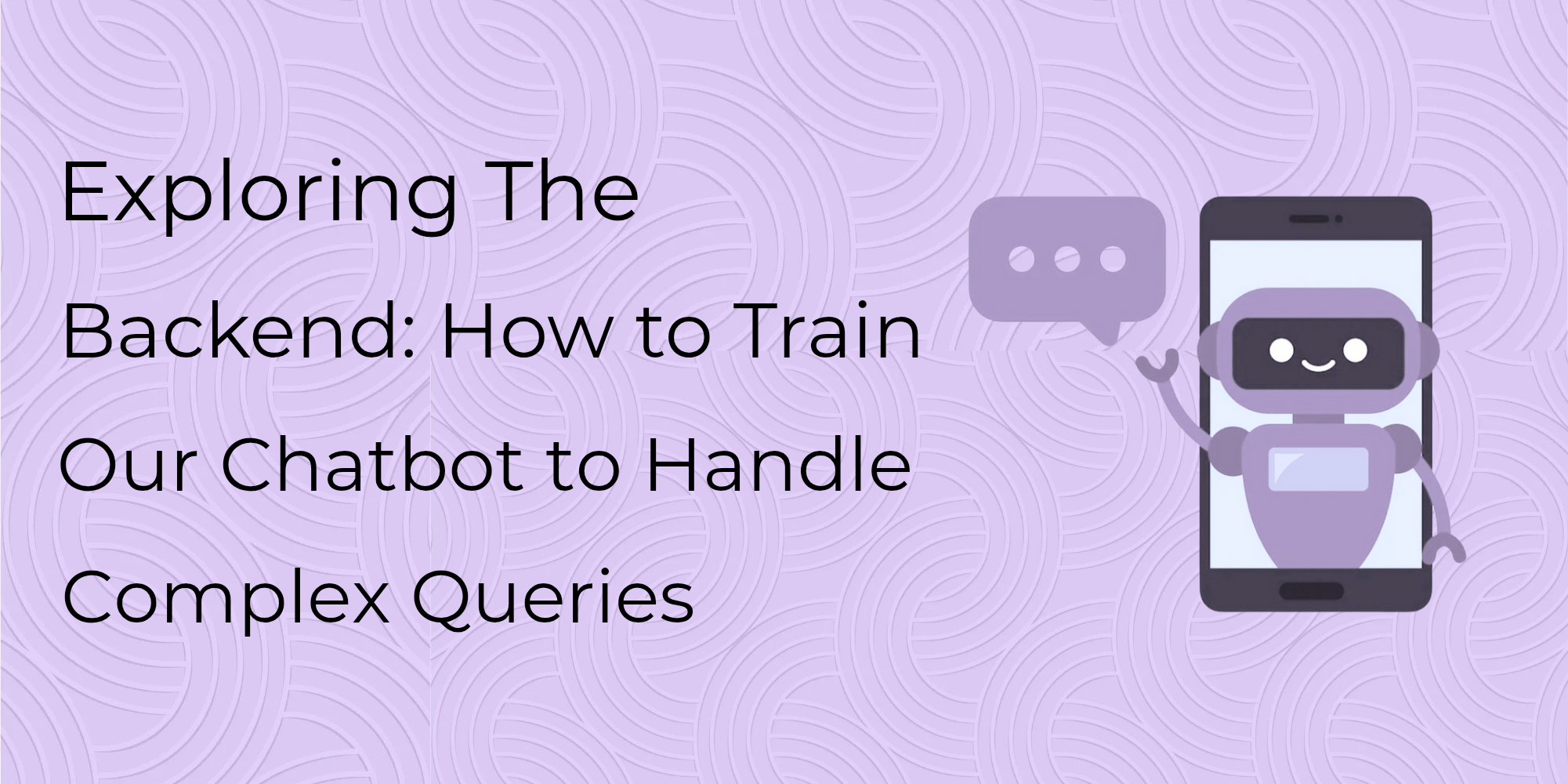In the digital age, chatbots have evolved from being basic, rules-based answerers to sophisticated AI-powered assistants that can master sophisticated conversations. But making a chatbot answer complicated questions—that is, ones beyond yes/no responses or basic fact-checking—calls for a careful strategy in backend development, machine learning (ML), and natural language processing (NLP).
● What Are Complicated Questions?
Before getting into technicalities, let’s first establish what exactly we call “complex queries.”
Complex Queries Include:
- Multiple intents or sub-questions
e.g., “Book me a flight to New York and suggest some fine Italian restaurants nearby.” - Contextual awareness
e.g., Following up with “What about next Friday?” after having discussed dates earlier. - Personalization and recall
e.g., remembering the user’s preference for window seats on flights or being vegetarian. - Resolving ambiguity
e.g., “Book me a ticket to Paris.” – Which one? France or Texas? - Multi-turn conversations
e.g., Managing follow-up questions across multiple conversational turns.
Intelligent training and architecture are required to overcome these challenges.
- Selecting the Correct Architecture
There are two broad categories of chatbot architectures:
A. Rule-Based Chatbots
These depend on predefined rules and keywords. Though quick and simple to implement, they are not good with complexity or nuance. Ideal for linear processes and FAQs.
B. AI-Powered (NLP + ML) Chatbots
These employ machine learning models, especially natural language understanding (NLU) and generation (NLG), to comprehend and respond more flexibly. For dealing with complicated questions, AI-powered bots are a must.
Popular Frameworks and Tools:
- Rasa
- Dialogflow CX
- Microsoft Bot Framework
- Botpress
- OpenAI GPT-based models
- Hugging Face Transformers
- NLP Pipeline
Behind every smart chatbot is a natural language processing pipeline. Here’s how it normally works:
NLP Pipeline Components:
- Text Preprocessing
Cleaning, tokenisation, and vectorisation of the input text. - Intent Recognition
Determining what the user intends (e.g., book_flight, get_weather). - Entity Extraction
Extracting important data (e.g., location: New York, date: Friday). - Context Management
Keeping conversational state across multiple turns. - Dialogue Management
Identifying the next response or action. - Response Generation
Applying templates or generative models to generate responses.
- Training the Intent Classifier
Training your model to effectively classify user intent is the first significant step.
Best Practices:
- Begin with varied training data.
Have variations in phrasing, tone, slang, and grammar. - Utilize data augmentation.
Automatically create paraphrased examples for added robustness. - Apply transfer learning.
Employ pretrained language models such as BERT, RoBERTa, or GPT to enhance understanding with minimal data. - Check accuracy.
Employ confusion matrices and F1 metrics to monitor how well your model separates similar intents.
- Slot Filling and Entity Extraction
Structured information (slots) extraction is essential for complicated queries.
Techniques:
- Rule-based extraction (regex or spaCy patterns) for structured domains.
- Machine learning-based NER using models such as CRF, BiLSTM-CRF, or BERT-based token classification.
Slot Types: - Mandatory slots (e.g., location, date for flight booking)
- Optional slots (e.g., meal choice, seat type)
Employ slot validation and prompts to verify ambiguous information. For instance:
User: “Book me a flight.”
Bot: “Sure, where are you flying to?”
User: “New York.”
Bot: “And when would you like to depart?”
- Dialogue and Context Management
Multi-turn dialogue demands your bot store context from turn to turn.
Methods:
- Finite-state machines (FSM): Suitable for linear flows.
- Contextual dialogue managers (e.g., in Rasa or Dialogflow CX) that maintain state, slots, and history of previous intents.
- Transformers with memory: GPT-type models that keep conversation context in attention layers.
For more complex scenarios: - Utilise session IDs and context variables to cache data.
- Store user profiles in a database for personalisation.
- Application of Knowledge Bases and APIs
Sophisticated queries tend to require access to external knowledge.
Examples:
- Weather or flight APIs
- Product inventory systems
- FAQ documents or search indexes as knowledge bases
Implementation: - Call external APIs via webhook or action endpoints.
- Deliver structured results, then translate them into human-readable responses.
User: “How is the weather in Tokyo this weekend?”
Bot: (calls the weather API) “It appears to be partly cloudy with a high of 22°C.”
Adding vector search or semantic search can assist the bot in seeking relevant information in unstructured documents.
- Ambiguity and Error Recovery
Your bot must be able to handle situations when it’s not sure or the user input is ambiguous.
Strategies:
- Clarification prompts: “Did you mean Paris, France, or Paris, Texas?”
- Fallback intents: Fired when confidence scores are low.
- Escalation to human agents: When necessary, transfer to a live agent.
Log all fallbacks for future training as well. Eventually, this helps the bot learn from its errors.
- Continuous Training and Improvement
AI chatbots are never actually “complete”. Ongoing learning is essential.
Steps:
- Gather actual conversations.
- Review failure instances and misclassifications.
- Refresh training data to include new intents or wording.
- Retrain models regularly to prevent concept drift.
Employ A/B testing to compare iterations of your chatbot and measure changes in user satisfaction or accuracy.
- Employing LLMs for Advanced Language Comprehension
Large Language Models (LLMs) such as GPT-4, Claude, or LLaMA add sophisticated features to chatbots, including:
- Improved interpretation of vague or indirect questions.
- Nuisance, contextualised responses to answering questions.
- Assistance with summarising, rephrasing, or translating questions.
You can either: - Utilise LLMs as backend processors (e.g., for complicated questions or summarising tasks).
- Construct the full bot interface with an LLM and fine-tune through prompt engineering.
LLMs, however, have their issues: - Greater cost and latency
- Less control over outputs
- Data privacy issues (except using on-prem or API with adequate precautions)
● Tools and Frameworks to Consider
Following are some tried-and-tested tools for constructing and training chatbots:
PurposeToolsNLU/MLRasa, spaCy, Hugging Face, OpenAIPurposeTools Dialogue Management Rasa, Botpress, Dialogflow CX, Microsoft Bot LLMs OpenAI (ChatGPT), Anthropic (Claude), Meta (LLaMA), MistralBackend/LogicNode.js, Python (Flask, FastAPI), ExpressAnalytics Botanalytics, Dashbot, Google Analytics Deployment AWS Lambda, Azure Functions, Heroku, Docker
● Real-World Use Case: Banking Support Bot
Let’s consider an example:
User: “I was billed twice for my Netflix subscription last month. Can you correct it?”
Behind the scenes, the bot:
- Detects intent: Billing problem → Duplicate bill
- Extracts entities: Service = Netflix, Date = last month
- Retrieves user’s billing details through API
- Evaluates rules: Was it actually charged twice? Was it a legitimate charge?
- Takes action: Processes a refund or offers explanation
- Closes loop: “Thanks for waiting! A refund has been processed and should be reflected in 3–5 business days.”
Conclusion
It is not necessarily a matter of throwing more training data or intents into the chatbot. It’s an end-to-end process that encompasses intelligent backend architecture, real-time data integration, dynamic conversation management, and ongoing learning. With the proper investment in architecture, tools, and training programs, you can build a chatbot that doesn’t merely reply—it understands, learns, and solves.
The future of chatbot AI is intelligence and depth. As people increasingly expect more from their online conversations, only the most talented bots will meet the challenge.


